ORDER
Charadriiformes
FAMILY
Scolopacidae
GENUS & SPECIES
KEY FEATURES
For a few weeks in spring, each breeding male wears a uniquely patterned feather collar, or ruff Rival males compete for mating rights in mock battles at communal arenas known as leks Embarks on marathon migrations each year, from the Arctic tundra to southern Africa
WHERE IN THE WORLD!
Breeds from Scandinavia and the Baltic Sea east across the Siberian Arctic; winters in western Europe, the Mediterranean, Africa and southern Asia
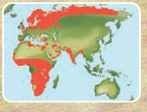
Lifecycle
Lengthening days of spring herald the return of the ruff to its lek, where rival males clash for supremacy and females gather to pick partners from the flamboyant contestants.
Habitat
Food & feeding
A trail of tiny marks in soft mud may mean a hungry ruff — the bird feeds by walking briskly as it jabs the ground with its slender bill. The flexible tip is packed with sensitive nerve endings and can be opened while the rest of the bill stays shut, letting the ruff feel for food and suck it up without having to see it. At other times, the ruff
swims into water to pick prey off the surface by sight. It also hunts insects, worms and snails, and occasionally a few seeds.
Fast and furious
A feeding ruff looks as if it’s stitching the ground.
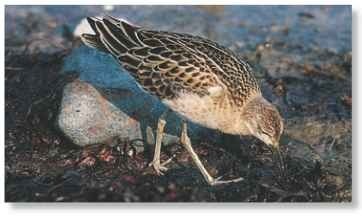
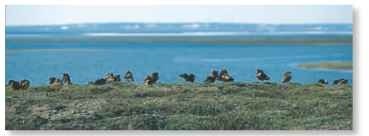
A Land of midnight sun Ruffs breed on Siberian tundra, where the summer is brief, but the sun never sets.
The ruff is a bird of open wetland habitats, but is less dependent on coasts and estuaries than other wading birds. In April and May, it
flies north to nest in marshes of northern Europe and tundra of Siberia and Scandinavia, where summer brings an abundance of invertebrates.
In July, large flocks of adults return south to temperate Europe,
southern Asia and Africa; their young follow a few weeks later. For up to eight months, they live on marshes, lake shores, damp meadows and rice paddies.
Winter holiday To avoid the winter, the ruff flies south to warmer wetland habitats.
conservation
The ruff has rarely been targeted by hunters, and humans have also had little impact on the remote tundra where it breeds. Sadly, the picture is different over the rest of its range. In Europe, the wetland stopover sites where it once recuperated in long migrations have been drained to create farmland.
Behavior
Neither the Arctic tundra nor flat, low-lying marshes afford much cover for the ruff, so it’s always alert for signs of danger: It forms feeding parties, often with other species of wading bird. As there are more eyes with which to spot predators, the whole flock is unlikely to be surprised: as soon as one bird detects potential danger; the entire group flies to safety. The female ruff, however, is vulnerable when incubating or tending very young chicks. If a predator nears her nest,she fakes injury flailing a wing as if it’s broken while zigzagging over the ground. She lures the enemy well away from the nest, before quickly taking off.
Sitting it out A nesting female’s first line of defense is to keep statue-still to avoid detection.
Breeding
Instead of setting up their own territories at the start of the breeding season, male ruffs congregate at display arenas called leks. They mock-fight to claim small patches of the lek for themselves, puffing out their neck collars, erecting their ear tufts and fluttering their wings as they fend off rivals. Females gather at the lek, attracted by the colorful commotion, and watch as ringside spectators. The male that claims the most sought-after part of the lek — often at its center — attracts the most admirers and mates with as many as he can; other males are only able to mate a few times.
Males play no further part in the breeding cycle and, once the females have left the lek, spend their time feeding. Even females have a short breeding season. After making a simple nest (grass-lined hollow hidden deep in vegetation), their only major task is to incubate a clutch of four eggs for three weeks. Chicks can run and feed soon after hatching and leave the nest the same day. Their mother supervises them for /eraI days, then they become entirely £i independent.
Every one unique Breeding plumage of every male is as individual as a human fingerprint.
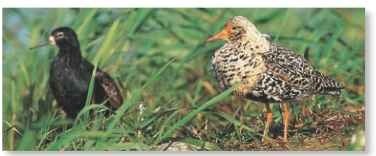
In waiting White plumaged “satellite” males sometimes snatch a chance to breed.
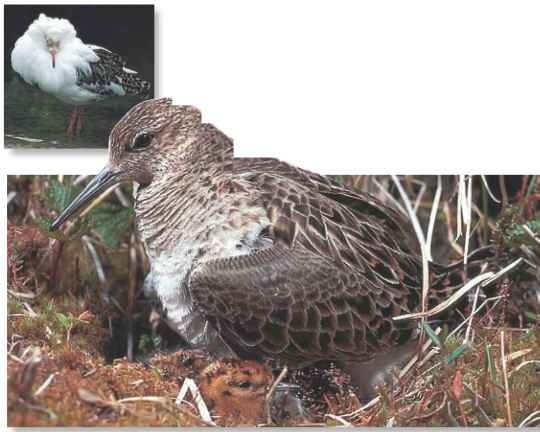
battle at the lek
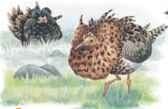
Dance…
A male ruff begins to dance at the lek, fluttering his wings and shaking his fully expanded ruff.
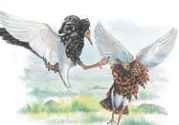
Leap…
He fights a rival for a better part of the lek, who responds by angrily kicking out with his legs.

Freeze…
All of a sudden, the two males “freeze” with their heads down.The newcomer’s ruff and ear tufts…

My hero
impress a female, who walks up and nibbles his ruff to show she wants to mate with him.
The term “lek” comes from the Swedish word meaning “to play.”
A ruff’s chicks leave the nest on the day they hatch, so it’s classed as nidifugous (nest-leaving). Birds that stay in the nest until they fledge are nidicolous (nest-attached).
Profile
RUFF
Many male birds are brighter than their mates, but the male ruff’s spring finery is exceptional. He parades in front of drab females as if in fancy dress.

CREATURE COMPARISONS
Nearly all wading birds, including the ruff, have long bills with narrow points, but the spoon-billed sandpiper (Eurynorhynchus pygmeus) is a striking exception to this rule.The sandpiper has a broad,
flattened bill, which widens into a spatula shape at the tip. It feeds by sweeping this bill from side to side over soft mud.
Half as large as a male ruff, or two-thirds a female’s size, the sandpiper has shorter legs and a slim profile. Unlike the ruff, the sexes look identical. Only 2,800 pairs are thought to remain, breeding ^in northeast Siberia and wintering in India and Southeast Asia.
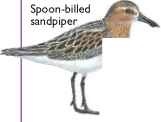
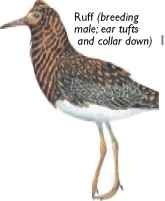
| Vital statistics | |
| Weight | Male 5-8 oz.; female 3-5 oz. |
| Length | Male 1′; female 0.8′ |
| Wingspan | 1-1.6′ |
| Sexual Maturity | 1-2 years |
| Breeding Season | May-August |
| Number of Eggs | 4 (rarely 3) |
| Incubation Period | 20-21 days |
| Fledging Period | Independent a few days after hatching |
| Breeding Interval | 1 year |
| Typical Diet | Insects; snails, other mollusks; worms, seeds |
| Lifespan | Up to 10 years |
Related species
• The male ruff’s breeding plumage placed the species in its own genus, Philomachus, one of 23 genera in the family Scolopacidae. With 85 species, this family has nearly half of the world’s wading birds, including sandpipers, curlews, snipes, woodcocks, turnstones, phalaropes, godwits and the only wading birds other than the ruff to use leks: the great snipe and I buff-breasted sandpiper.


